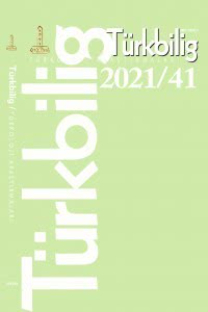Türkçede Türetkenlik ve Türetkenliği Ölçme Yöntemleri
Biçimbilgisi araştırmacılarının önemli çalışma alanlarından biri gramatikal işlevleri inceleyen çekim morfolojisidir diğeri ise yeni kelime yapım yollarıyla uğraşan türetim morfolojisidir. Artzamanlı ve eşzamanlı geleneksel araştırmalarda türetim eklerinin özellikleri, işlevleri sıkça çalışılmış ve bu eklerin türetkenlikleri genel hatlarıyla anlatılmıştır. Tanımlanması ve ölçülmesi zor olan biçimbilgisel türetkenlik; saydamlık, kullanışlılık ve tabanın kullanım sıklığı gibi kavramlarla doğrudan ilişkilidir. Aynı zamanda türetim eklerinin kök ve gövdelere eklenmesi sesbilgisel, biçimbilgisel, anlamsal vb. birçok sınırlılıkla gerçekleşir. Bu sınırlılıklara bağlı olarak gerçekleşen biçimbilgisel türetkenlik işlemini çeşitli yöntemlerle ölçmek de mümkündür. Türetkenliği ölçmenin ilk yolu belli bir ekle türetilmiş kelimeleri saymaktır. Tarihi veriler için uygun olan bu yöntem bir dilin mevcut türetkenliğini ölçme konusunda yetersiz kalır. Türetkenliği ölçme işlemine bir ekle türetilmiş bir kerelik türetimleri hapaxes katmak türetkenliği anlamada yeni bakış açıları sunar
Anahtar Kelimeler:
zihinsel sözlük, morfolojik türetkenlik, türetkenlikte sınırlılıklar, türetkenliği ölçme yöntemleri
Productivity in Turkish and Methods for Measuring Productivity
One of the study fields of morphology is Inflectional Morphology which covers the grammatical functions of the suffixes. Derivational Morphology, on the other hand, deals with word-formation rules of the language. Traditional Synchronic and diachronic studies examine the properties, etymologies and functions of the derivational suffixes and their productivity are described with basic terms. The morphological productivity which is difficult to define and measure is directly related with the notion of the transparency, usefulness and frequency of the base. Moreover, there are some phonological, morphological, syntactic, and semantic constraints of productivity. It is possible to measure the process of morphological productivity with different proposed methods. The first way to measure productivity is to count the number of different words generated with the suffix in question. This method suitable to measure historical productivity is not sufficient for the present time productivity of the language. There are other methods in linguistics literature which include “hapax legomena” which are the words that occur only once in a given corpus. The method including “hapaxes” offers new perspectives on morphological productivity
Keywords:
morphological productivity, productivity constraints, measurements of morphological productivity,
___
- ARONOFF, Mark (1976), Word Formation in Generative Grammar, Cambridge, Massachusetts, and London: The MIT Press.
- ARONOFF, Mark & FUDEMAN, Kirsten Anne (2011), What is morphology?, Oxford: Wiley-Blackwell.
- BANGUOĞLU, Tahsin (2004), Türkçenin Grameri, Ankara: Türk Dil Kurumu.
- BAUER, Laurie (2001), Morphological productivity, Cambridge: Cambridge University Press.
- BAUER, Laurie (2003), Introducing Linguistic Morphology, Edinburgh: Edinburgh University Press.
- EDİSKUN, Haydar (1996), Türk Dilbilgisi: Sesbilgisi-Biçimbilgisi-Cümlebilgisi, İstanbul: Remzi Kitabevi.
- ERGİN, Muharrem (1985), Türk Dil Bilgisi, İstanbul: Boğaziçi Yayınları.
- KATAMBA, Francis (1993), Morphology, Basingstoke: Macmillan.
- LIEBER, Rochelle (2009), Introducing Morphology, Cambridge: Cambridge University Press.
- PLAG, Ingo (2003), Word-formation in English, Cambridge: Cambridge University Press.
- PLAG, Ingo (2006), Productivity, Bas Aarts, A. M. (Ed.), The Handbook of English Linguistics, Oxford: Blackwell Publishing. 537-556.
- TUD Türkçe Ulusal Derlem, http://www.tnc.org.tr/index.php/tr/anasayfa, ET: 15 Nisan 2016.
- UZUN, N. Engin, Uzun, L. S., Aksan, M. & Aksan, Y. (1992), Türkiye Türkçesinin Türetim Ekleri Bir Döküm Denemesi, Ankara: Şirin Kırtasiye.
- ZÜLFİKAR, Hamza (1991), Terim Sorunları ve Terim Yapma Yolları, Ankara: Türk Dil Kurumu.
- ISSN: 1302-6011
- Yayın Aralığı: Yılda 2 Sayı
- Başlangıç: 2000
- Yayıncı: Doç. Dr. Bülent Gül
Sayıdaki Diğer Makaleler
AFGANİSTAN'IN DİL POLİTİKASI VE AFGANİSTAN'DA TÜRKÇE EĞİTİMİ TARİHİ
Fahri TEMİZYÜREK, Mete Yusuf USTABULUT, Erol BARIN
TIVA TÜRKLERİNDE GEÇİŞ DÖNEMİ RİTÜELLERİ: DOĞUM, DÜĞÜN, ÖLÜM
FERAH TÜRKER, VİLDAN KOÇOĞLU GÜNDOĞDU
TELEÜT ATASÖZLERİNDEN SEÇMELER -I
ESKİ TÜRKÇE tarı?çı "TARIMCI, EKİNCİ" ADI ÜZERİNE
Oğuznamecilik Geleneği ve Milli Destan Şairimiz Basri Gocul
Bugünkü Buryatçada Türkçe Kökenli Kelimeler
ESKİ UYGUR TÜRKÇESİNDE NİCELEYEN VE NİCELENEN İLE KURULMUŞ YAPILARDA ÇOKLUK UYUMU
Duygu Özge GÜRKAN, Ayşe KILIÇ CENGİZ
TOFA (KARAGAS) TÜRKLERİNİN ATASÖZLERİ
ET-TUHFETÜ'Z-ZEKİYYE Fİ'L-LÛGATİ'T-TÜRKİYYE HAKKINDA BAZI AÇIKLAMALAR
